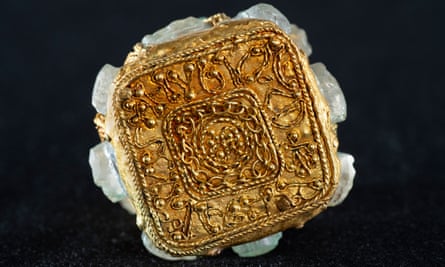When the Galloway hoard was unearthed from a ploughed field in western Scotland in 2014, it offered the richest collection of Viking-age objects ever found in Britain or Ireland. But one of the artefacts paled in comparison with treasures such as a gold bird-shaped pin and a silver-gilt vessel because it was within a pouch that was mangled and misshapen after almost 1,000 years in the ground.

Now that pouch has been removed and its contents restored, revealing an extraordinary Roman rock crystal jar wrapped in exquisite layers of gold thread by the finest medieval craftsman in the late eighth or early ninth century.
About 5cm high, it may once have held a perfume or other prized potion used to anoint kings, or in religious ceremonies. It had been carefully wrapped in a silk-lined leather pouch, reflecting its significance.

The hoard, which included about 100 objects, was buried around AD900 and contained artefacts from the Anglo-Saxon kingdoms, Ireland and as far away as Asia. It was unearthed by a metal detectorist on what is now Church of Scotland land in Kirkcudbrightshire.
After a fundraising campaign to raise £2m, it was acquired by National Museums Scotland in 2017.
Dr Martin Goldberg, NMS’s principal curator of early medieval and Viking collections, described the jar as “really beautiful” and all the more exceptional because his research has led him to conclude that the rock crystal carving was in fact Roman. It was perhaps 600 years old by the time it was transformed into a gold-wrapped jar.
He said: “So it’s a really surprising and unique object.”

Dr Leslie Webster, former keeper of Britain, prehistory and Europe at the British Museum, said: “Rock crystal is unusual in itself. It … was greatly prized in the antique world for its transparency and translucency, and so it’s associated with purity. So it was, I think even in its time, very, very special …
“I’ve seen a lot of Anglo-Saxon finds over the years in my professional career, some of them amazing. But this absolutely knocks them all into a cocked hat.”
The restoration has revealed an unexpected Latin inscription on the jar’s base. Spelled out in gold letters, it translates as “Bishop Hyguald had me made”. This is crucial evidence that some of the hoard’s material may have come from a church in the Anglo-Saxon kingdom of Northumbria, which included Dumfries and Galloway and stretched as far north as Edinburgh and as far south as Sheffield.
At the start of the 10th century, Alfred the Great was pushing back the Danes, laying the foundations of medieval England and Alba, the kingdom that became medieval Scotland. It is unclear whether the hoard was buried by a Viking – Norse sagas refer to riches being buried to be accessed in the afterlife – or someone fearing Viking raids at a time when ecclesiastical treasures were being robbed from monasteries.
Goldberg said that silk was then a particularly luxurious and exotic material: “It’s come from Asia, so it’s travelled thousands of miles. It’s an example of how precious they thought this object inside was,” he said.
Although Bishop Hyguald may have been a prominent figure in Northumbrian ecclesiastical circles, church chronicles of the period are incomplete, partly because of the Viking invasions.
Goldberg expressed excitement at finding the name. “So much of the past is anonymous, especially when you’re looking at very early history,” he said. “There are very few names to work with. But this is adding new information, building a much richer picture.”
The rock crystal design resembles the capital of a Corinthian column, with carved lobes that look like foliage, he realised. “It’s almost a perfect model of a Corinthian column, but the scale is minute,” he said.
There is the possibility that this jar still bears trace elements of the potion it once held and that its precise chemicals can be revealed.
Goldberg said: “The type of liquid that we would expect would be something very exotic, perhaps a perfume from the Orient, something’s that’s travelled in the same way that the silk has. There were certain types of exotic oil that were used in anointing kings and ecclesiastical ceremonies.”
Ninety-seven of the hoard’s artefacts are included in a touring exhibition, titled The Galloway hoard: Viking-age treasure. It is at Kirkcudbright Galleries, near the site of its discovery, until 10 July, transferring to Aberdeen Art Gallery from 30 July to 23 October. The jar is undergoing final work but, from Monday, a new film and digital model will be featured.





